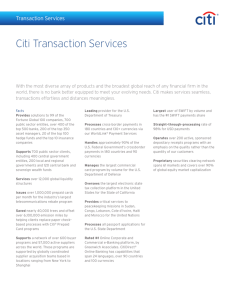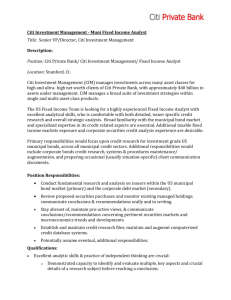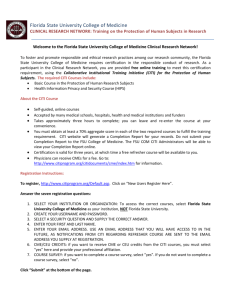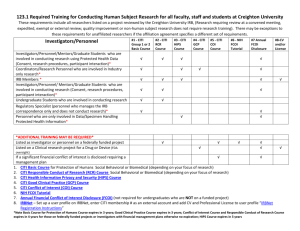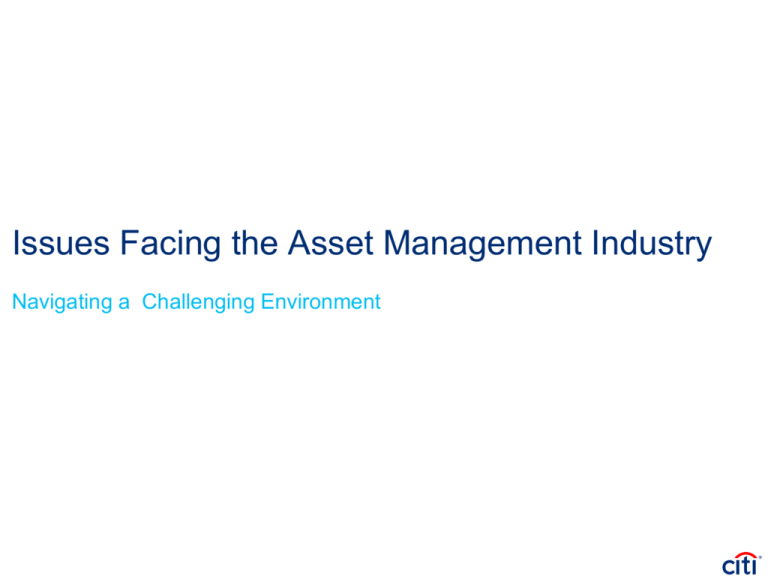
Issues Facing the Asset Management Industry
Navigating a Challenging Environment
Top Issues Facing Asset Managers
Primary challenges that Citi sees our asset manager clients facing
Regulatory
Complexity
Growth
Operational
Efficiency
Market
Volatility
1
General Observations
Risk
Management
Regulatory Complexity
Regulatory complexity is a constantly evolving concern for the industry
New regulations require that advisors to private funds to register with the SEC as investment advisers, submit new
information on Form ADV
In order to comply with FATCA, additional data will need to be collected, analyzed and reported
– Asset managers will need to work with their service providers to put in place systems to comply with data computation and
reporting requirements
Private Fund Managers to submit data on new form PF, intended to provide the government with a measure of systemic risk
The SEC is taking steps to investigate and bring enforcement cases in the asset management industry
– Enforcement staff is investigating practices (ineffective compliance program, abuses involving valuation, sales practices
and disclosure, allocations of expenses and securities, performance claims, insider trading, and other types of compliance
programs)
Investors, clients and prospective clients looking for greater transparency and confidence that the manager has strong
compliance and internal controls
Regulatory Risk Considerations
Valuation
2
Insider Trading
Regulatory Reporting
Compliance Program
Institutional Conflicts
Investment Guidelines
And Restrictions
Trading
Safeguarding Investor
Assets
Personal Conflicts
Market Practices
Risk Disclosures
General Observations
Risk Management
Factors to consider; steps to take
Economic Risks
– Economic uncertainty and resulting correlation and
convergence of risk factors – credit, market, liquidity
and valuation risk – during heightened market
volatility and stress
– Need for a proactive and risk management program
Tax Risks
– Tax no longer an adjunct function, becoming fully
integrated part of the firm’s risk management
function
External Forces
– Increasingly complex regulatory climate significantly
increased demands for risk oversight
– Investors expect institutional quality governance,
processes and controls from their asset managers
Regulatory Agencies
SEC – conducting investigations stemming from
problems that emerged from the financial crisis
IRS (and global counterparts) – have increased
activities, performing audits (firms need to prepare
form audits)
3
General Observations
Adjust
Risk management programs to
place greater emphasis on emerging risks
Reassess
Managers are looking to reassess their tax
functions which are being asked to address new
compliance requirements and more complex processes.
Focus
On strengthening the linkages between risk,
regulations and business strategy. As well as a focus on
operational, compliance, service provider, tax, fraud, and
liquidity risks
Market Volatility
Regulatory challenges, data demands, and evolving market dynamics are influencing
the priorities for asset managers
Transparency
New awareness among asset management stakeholders including investors, consultants and
regulators has created a demand for transparency in fund management
– Rethinking of organizational structures and governance models
– Greater voice of the shareholder
– More frequent due diligence
Data Dependency
New and evolving asset classes create a greater need for data
– Highly sophisticated system needs with the ability for real-time reporting drives up technology
costs. Build vs. buy
Legacy and disparate systems create the need for consolidated “Dashboard” reporting
Need for data experts – in-house vs. outsourced
$1.3Tr in Net Inflows since 2008, captured by primarily 10 industry players
Investor Dynamic
Flows have been mainly into (1) Passive Products, (2) Outcome-oriented Products, and (3)
Alternative products
– Most players are only dominant in one category; only 25% of the Top 10 are dominant in 2, and
only 1 is dominant in all 3 categories
$400Bn in outflows from relative return equity strategies
4
General Observations
Macroeconomic and Industry Trends
Globalization & EMs Driving
Global Growth
Significant Deleveraging
(by European Banks)
Liquidity Pools Need
to be Invested
Global Need for Credit
Growth by 2030 –
– Global trade flows: $37Tr to $122Tr, w/EM driving 72% of growth
– Global equity market cap: $44Tr to $185Tr, w/EM driving 70% of growth
– EM companies in FT Global 500: 134 to 284
European asset deleveraging: €1.5 - €2.5Tr in assets need to be placed with
new owners
Lower ongoing lending capacity
Global corporate cash $4.2Tr
Sovereign Wealth Fund assets of $4.8Tr to grow to $12-15Tr by 2020
Additional global credit need of $100Tr by 2020
– Includes ~$30b for infrastructure
Economic uncertainty and low interest rates
Increasing Complexity of Liquidity
Management
Evolving regulatory / tax environment
Rising pension fund liabilities and funding gaps
Growth
Options for growth – two schools of thought
Organic
Keys to Success:
Opportunities:
Strong brand positions
Fragmented M&A sector with little activity
Restructuring to strengthen market position,
revenue and earnings
Market is mature, sustainable organic growth
difficult to achieve
Strong culture
M&A can create a competitive advantage, which
could increase efficiencies
Key talent acquisition and retention
Innovative product offering
Better analytics for distributors and end investors
Improved customer experience and transparency
5
M&A
General Observations
North American asset management firms are likely
to return to the market when the conditions improve
Private Equity Firms are playing a growing role in
the new deal-making, with participation only likely to
improve
Operational Efficiency
Profits post-2008 are 20% lower, creating a need for focused operating discipline
Demands on asset manager operations functions are growing due to expanded regulatory oversight, new
rules and new and more complex asset classes and investment strategies and growing investor expectations
– Reporting requirements require sophisticated systems to support requests, especially when real-time data
is required
Market volatility has concentrated the attention of asset managers on their operational processes as a way to
control costs
– Many asset managers are seeking greater multi-asset class coverage within their support platform
Focusing on technology and operations enhancements to drive efficiencies
– Asset Managers investing more heavily in data management strategies and platforms to improve efficiency,
management reporting, and compliance reporting and oversight
– Many managers have multiple legacy systems, often with different technology platforms (thereby making
gathering data inefficient)
– Workflow management tools are increasingly being used to standardize both system and operational
processes to improve efficiency, increase transparency, and create and increased STP rate
Asset managers are seeking to drive operational efficiencies in response to industry-wide drivers such as fee
compression and flat or decreasing asset levels
Effective execution of a talent strategy is challenged by firm growth (either organic or through acquisitions), as
well as the significant increase in necessity of large compliance / risk departments
– The use of alternative talent pools models to mange supply and demand peaks
5
General Observations
Challenges
Risk complexity and market volatility
– Transparency / Reporting,
– Independent Valuations
– OTC appetite
– Risk management
Growth
– Different asset classes / new products,
– Geographic expansion
– New client segments
Operational efficiencies
– Outsourcing
– Offshoring
– Geographic location,
– Service model requirements,
– Governance models
6
General Observations
Are these your challenges?
Did we miss any?
How are you dealing with these?
How should Citi deal with these challenges and
how can we assist you in the best possible way?
Breakout Session Groups
Group 1 – Room E
Group 2 – Room G
Group 3 – Room F
Salient
Morgan Creek
BlackRock
Victory
UBS
Fidelity
Legal & General
Goldman Sachs
Wellington
AEGON
Apollo
Franklin Templeton
Forward
Scout
Oppenheimer
Janus
Fidelity
Dimensional
7
General Observations
IRS Circular 230 Disclosure: Citigroup Inc. and its affiliates do not provide tax or legal advice. Any discussion of tax matters in these materials (i) is not intended or written to be used, and cannot be used or
relied upon, by you for the purpose of avoiding any tax penalties and (ii) may have been written in connection with the "promotion or marketing" of any transaction contemplated hereby ("Transaction").
Accordingly, you should seek advice based on your particular circumstances from an independent tax advisor.
In any instance where distribution of this communication is subject to the rules of the US Commodity Futures Trading Commission (“CFTC”), this communication constitutes an invitation to consider entering
into a derivatives transaction under U.S. CFTC Regulations §§ 1.71 and 23.605, where applicable, but is not a binding offer to buy/sell any financial instrument.
However, this is not a recommendation to enter into any swap with any counterparty or a recommendation of a trading strategy involving a swap. Prior to recommending a swap or a trading strategy involving
a swap to you, Citigroup would need to undertake diligence in order to have a reasonable basis to believe that the recommended swap or swap trading strategy is suitable for you, obtain written
representations from you that you are exercising independent judgment in evaluating any such recommendation, and make certain disclosures to you. Furthermore, nothing in this pitch book is, or should be
construed to be, an offer to enter into a swap.
Any terms set forth herein are intended for discussion purposes only and are subject to the final terms as set forth in separate definitive written agreements. This presentation is not a commitment to lend, syndicate a
financing, underwrite or purchase securities, or commit capital nor does it obligate us to enter into such a commitment, nor are we acting as a fiduciary to you. By accepting this presentation, subject to applicable law or
regulation, you agree to keep confidential the information contained herein and the existence of and proposed terms for any Transaction.
Prior to entering into any Transaction, you should determine, without reliance upon us or our affiliates, the economic risks and merits (and independently determine that you are able to assume these risks) as well as the legal,
tax and accounting characterizations and consequences of any such Transaction. In this regard, by accepting this presentation, you acknowledge that (a) we are not in the business of providing (and you are not relying on us
for) legal, tax or accounting advice, (b) there may be legal, tax or accounting risks associated with any Transaction, (c) you should receive (and rely on) separate and qualified legal, tax and accounting advice and (d) you
should apprise senior management in your organization as to such legal, tax and accounting advice (and any risks associated with any Transaction) and our disclaimer as to these matters. By acceptance of these materials,
you and we hereby agree that from the commencement of discussions with respect to any Transaction, and notwithstanding any other provision in this presentation, we hereby confirm that no participant in any Transaction
shall be limited from disclosing the U.S. tax treatment or U.S. tax structure of such Transaction.
We are required to obtain, verify and record certain information that identifies each entity that enters into a formal business relationship with us. We will ask for your complete name, street address, and taxpayer ID number.
We may also request corporate formation documents, or other forms of identification, to verify information provided.
Any prices or levels contained herein are preliminary and indicative only and do not represent bids or offers. These indications are provided solely for your information and consideration, are subject to change at any time
without notice and are not intended as a solicitation with respect to the purchase or sale of any instrument. The information contained in this presentation may include results of analyses from a quantitative model which
represent potential future events that may or may not be realized, and is not a complete analysis of every material fact representing any product. Any estimates included herein constitute our judgment as of the date hereof
and are subject to change without any notice. We and/or our affiliates may make a market in these instruments for our customers and for our own account. Accordingly, we may have a position in any such instrument at
any time.
Although this material may contain publicly available information about Citi corporate bond research, fixed income strategy or economic and market analysis, Citi policy (i) prohibits employees from offering, directly or indirectly,
a favorable or negative research opinion or offering to change an opinion as consideration or inducement for the receipt of business or for compensation; and (ii) prohibits analysts from being compensated for specific
recommendations or views contained in research reports. So as to reduce the potential for conflicts of interest, as well as to reduce any appearance of conflicts of interest, Citi has enacted policies and procedures designed to
limit communications between its investment banking and research personnel to specifically prescribed circumstances.
[TRADEMARK SIGNOFF: add the appropriate signoff for the relevant legal vehicle]
© 2013 Citigroup Global Markets Inc. Member SIPC. All rights reserved. Citi and Citi and Arc Design are trademarks and service marks of Citigroup Inc. or its affiliates and are used and registered throughout the world.
© 2013 Citigroup Global Markets Limited. Authorized and regulated by the Financial Services Authority. All rights reserved. Citi and Citi and Arc Design are trademarks and service marks of Citigroup Inc. or its affiliates and
are used and registered throughout the world.
© 2013 Citibank, N.A. All rights reserved. Citi and Citi and Arc Design are trademarks and service marks of Citigroup Inc. or its affiliates and are used and registered throughout the world.
© 2013 Citigroup Inc. All rights reserved. Citi and Citi and Arc Design are trademarks and service marks of Citigroup Inc. or its affiliates and are used and registered throughout the world.
© 2013 [Name of Legal Vehicle] [Name of regulatory body.] All rights reserved. Citi and Citi and Arc Design are trademarks and service marks of Citigroup Inc. or its affiliates and are used and registered throughout the world.
Citi believes that sustainability is good business practice. We work closely with our clients, peer financial institutions, NGOs and other partners to finance solutions to climate change, develop industry standards, reduce our
own environmental footprint, and engage with stakeholders to advance shared learning and solutions. Highlights of Citi’s unique role in promoting sustainability include: (a) releasing in 2007 a Climate Change Position
Statement, the first US financial institution to do so; (b) targeting $50 billion over 10 years to address global climate change: includes significant increases in investment and financing of renewable energy, clean technology,
and other carbon-emission reduction activities; (c) committing to an absolute reduction in GHG emissions of all Citi owned and leased properties around the world by 10% by 2011; (d) purchasing more than 234,000 MWh of
carbon neutral power for our operations over the last three years; (e) establishing in 2008 the Carbon Principles; a framework for banks and their U.S. power clients to evaluate and address carbon risks in the financing of
electric power projects; (f) producing equity research related to climate issues that helps to inform investors on risks and opportunities associated with the issue; and (g) engaging with a broad range of stakeholders on the
issue of climate change to help advance understanding and solutions.
Citi works with its clients in greenhouse gas intensive industries to evaluate emerging risks from climate change and, where appropriate, to mitigate those risks.
efficiency, renewable energy and mitigation


